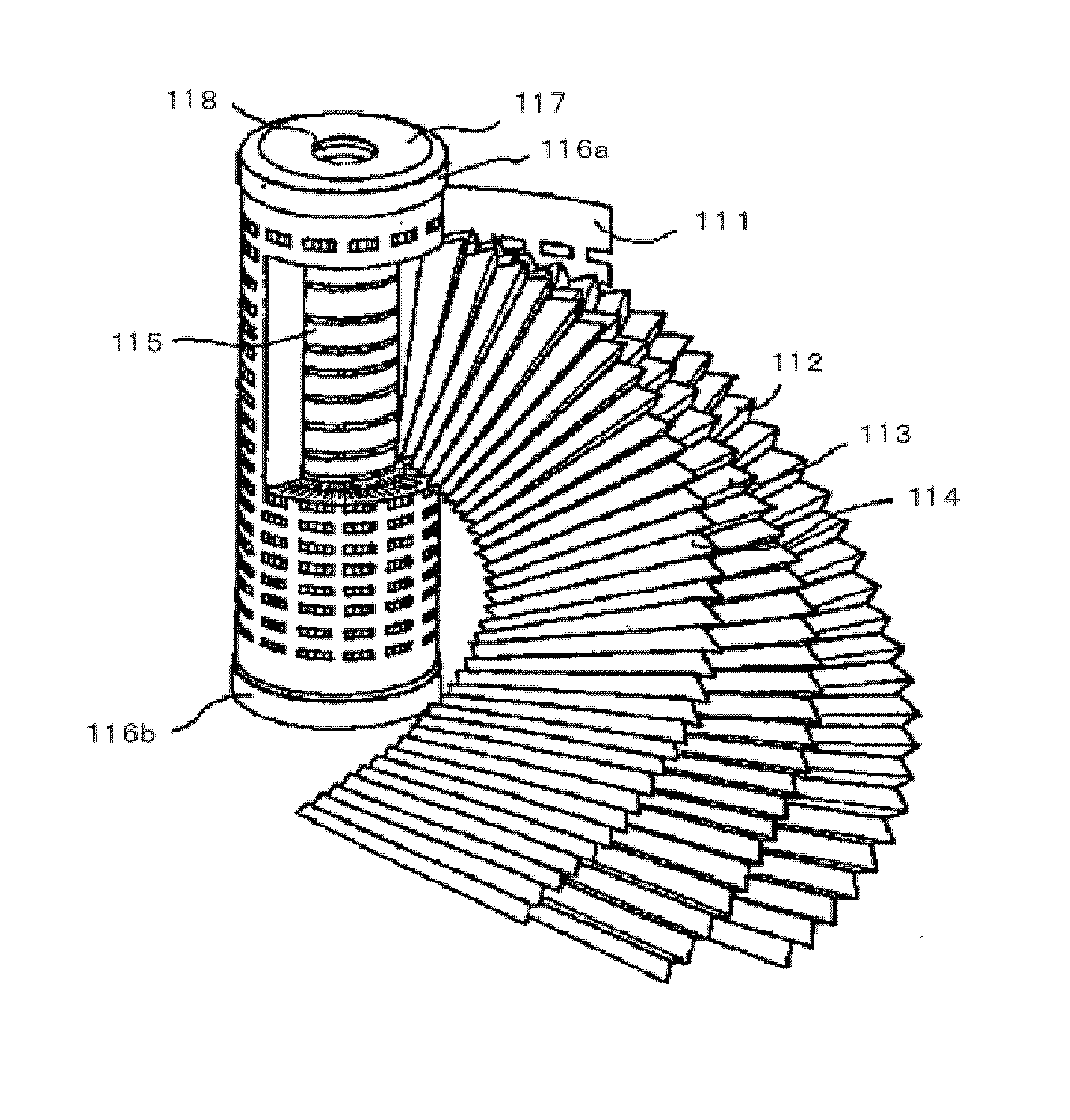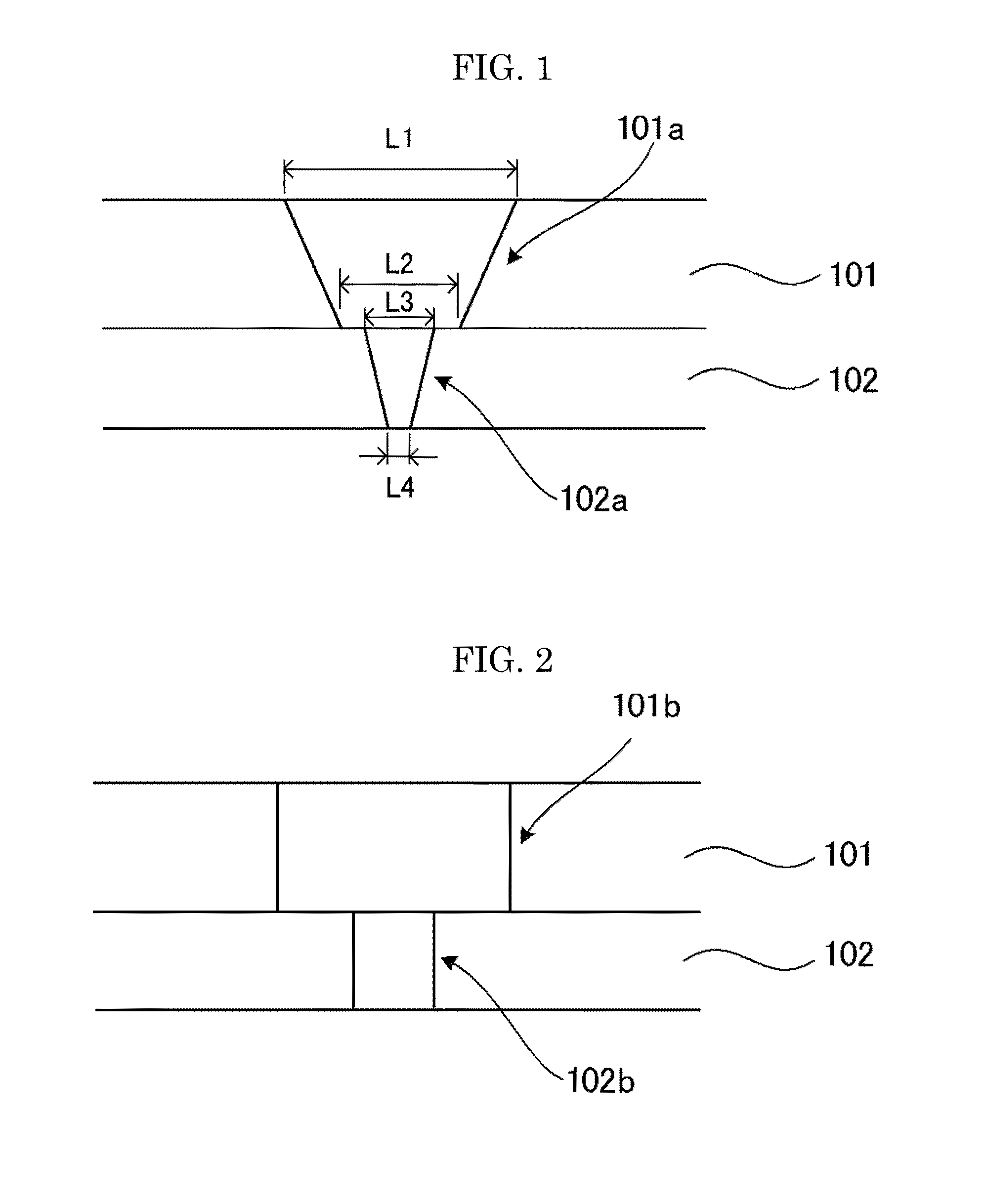Crystalline polymer microporous membrane, method for producing the same, and filtration filter using the same
a technology of crystalline polymer and microporous membrane, which is applied in the direction of membranes, filtration separation, separation processes, etc., can solve the problems of difficult to satisfy all the required properties of the membrane, and the porous ptfe membrane prepared by such methods cannot efficiently capture fine particles, etc., to achieve efficient capture of fine particles, avoid clogging, and high filtration rate
- Summary
- Abstract
- Description
- Claims
- Application Information
AI Technical Summary
Benefits of technology
Problems solved by technology
Method used
Image
Examples
example 1
—Preparation of Preforming Body (Molding Step)—
[0192]To 100 parts by mass of polytetrafluoroethylene fine powder (F106, manufactured by DAIKIN INDUSTRIES, LTD., crystallinity: 98.5%) serving as a high crystalline polymer, 23 parts by mass of hydrocarbon oil (ISOPAR H, manufactured by Esso Sekiyu K.K.) serving as an extrusion aid was added to prepare Paste 1.
[0193]To 100 parts by mass of polytetrafluoroethylene fine powder (F205, manufactured by DAIKIN INDUSTRIES, LTD., crystallinity: 93.7%) serving as low crystalline polymer, 20 parts by mass of hydrocarbon oil (ISOPAR H, manufactured by Esso Sekiyu K.K.) serving as an extrusion aid was added to prepare Paste 2.
[0194]Then, Paste 1 was laid and compressed at the pressure of 0.5 MPa, pressure application duration of 10 seconds, and the highest reaching temperature of 36° C. to thereby prepare Preforming Body 1 having a thickness of 70 mm.
[0195]Thereafter, Paste 2 was laid and compressed at the pressure of 0.5 MPa, pressure application...
example 2
[0209]A polytetrafluoroethylene microporous membrane of Example 2 was prepared in the same manner as in Example 1, provided that instead of laminating Extrusion Body 1 and Extrusion Body 2 in the order of Extrusion Body 1 / Extrusion Body 2 / Extrusion Body 1, so as to have thicknesses (Extrusion Body 1, Extrusion Body 2, and Extrusion Body 1) of 6.0 mm, 3.0 mm, 6.0 mm, respectively, and the thickness ratio (thickness of Extrusion Body 1 / Extrusion Body 2 / Extrusion Body 1) of about 2 / 1 / 2, Extrusion Body 1 and Extrusion Body 2 were laminated so as to have thicknesses (Extrusion Body 1, and Extrusion Body 2) of 12 mm, and 3 mm, respectively, and the thickness ratio (the thickness of Extrusion Body 1 / the thickness of Extrusion Body 2) of 4 / 1 to form a laminate of two layers, and instead of heating the obtained unbaked multilayer polytetrafluoroethylene film for 26 seconds by the roller (surface material: SUS316) whose temperature was maintained at 338° C., the surface of the unbaked multila...
example 3
[0210]A polytetrafluoroethylene microporous membrane of Example 3 was prepared in the same manner as in Example 1, provided that instead of laminating Extrusion Body 1 and Extrusion Body 2 in the order of Extrusion Body 1 / Extrusion Body 2 / Extrusion Body 1, so as to have thicknesses (Extrusion Body 1, Extrusion Body 2, and Extrusion Body 1) of 6.0 mm, 3.0 mm, 6.0 mm, respectively, and the thickness ratio (thickness of Extrusion Body 1 / Extrusion Body 2 / Extrusion Body 1) of about 2 / 1 / 2, Extrusion Body 1 and Extrusion Body 2 were laminated so as to have thicknesses (Extrusion Body 1, Extrusion Body 2, Extrusion Body 1) of 6.0 mm, 3.0 mm, and 3.0 mm, respectively, and the thickness ratio (the thickness of Extrusion Body 1 / the thickness of Extrusion Body 2 / the thickness of Extrusion Body 1) of 2 / 1 / 1 to form a laminate of three layers. Note that, a surface of the unbaked multilayer polytetrafluoroethylene film at the side where Extrusion Body 1 having a thickness of 3.0 mm was present was ...
PUM
| Property | Measurement | Unit |
|---|---|---|
| pressure | aaaaa | aaaaa |
| temperature | aaaaa | aaaaa |
| pressure | aaaaa | aaaaa |
Abstract
Description
Claims
Application Information
 Login to View More
Login to View More - R&D
- Intellectual Property
- Life Sciences
- Materials
- Tech Scout
- Unparalleled Data Quality
- Higher Quality Content
- 60% Fewer Hallucinations
Browse by: Latest US Patents, China's latest patents, Technical Efficacy Thesaurus, Application Domain, Technology Topic, Popular Technical Reports.
© 2025 PatSnap. All rights reserved.Legal|Privacy policy|Modern Slavery Act Transparency Statement|Sitemap|About US| Contact US: help@patsnap.com



